The 15th edition of the Gold Silver Time jewellery fair opened its doors on a warm October 2 in Warsaw, Poland to an enthusiastic crowd of visitors who came to see the original products from a wide range of Polish designers and manufacturers.
-
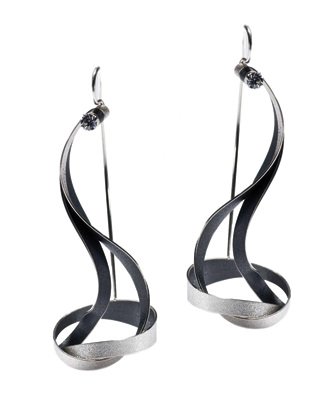
- Freeform silver earrings by Arek Wolski, an innovative designer who says he used to work in amber but now prefers metal.
Attracting more than 6000 visitors, the three-day Gold Silver Time (GST) show featured more than 300 exhibitors showcasing original jewellery, silverware, and watches in a range of metals, including silver, gold, titanium, and steel, as well as a variety of unusual materials such as acrylic and resin.
-

- “White Grapes” necklace of amber by Agata Calka for Amber-Ring (left)
Designer Marta Wlodarska uses amber in combination with driftwood that she picks up from Baltic Sea beaches, where amber is found. Her sculptural pieces are sold under her brand, Amberwood.(right)
In his opening remarks at the start of the show, Rafał Galimski, president of MCT International Fair Centre, emphasized the very close relationships between the GST organizers and the jewellery community, including trade organizations, education and outreach institutions, and “GST’s 15-year-long contribution to promoting jewellery art and artistic craftsmanship and to building a positive image of Polish design.”
-
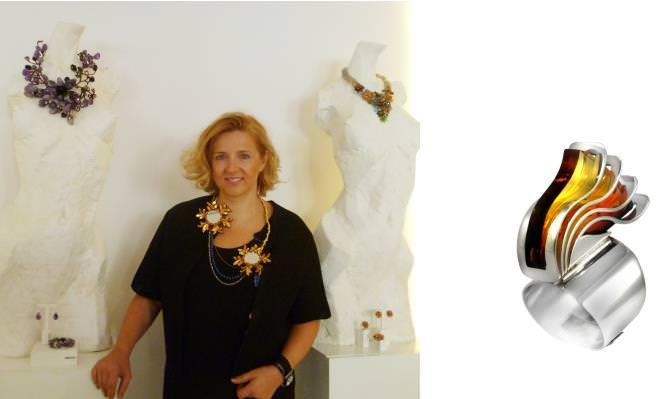
- Award-winning Ewa Lewanowicz in her showroom in Warsaw. Under the Lewanowicz brand, she creates jewellery in sterling silver and natural gems, as well as fashion pieces combining a variety of materials metal, crystals, stones (left)
Amber and silver statement ring by designer, Jacek Ostrowski, who also has a line of watches featuring amber bezels.(right)
After only a few minutes walking the show floor, the positive image of Polish design was clearly evident. The product offer was extensive and original. And, it could be divided into three general design directions: Classics, Fashion, and Design. The Classics comprised mainly gold with diamonds and gemstones, plus silver with natural or synthetic gems, while Fashion followed the current trends, drawing inspiration from colour, texture, nature, geometric, and cultural motifs. The Design group featured a varied range of designers who interpret jewellery in their own manner, and whose creativity and originality attracted a lot of interest.
-
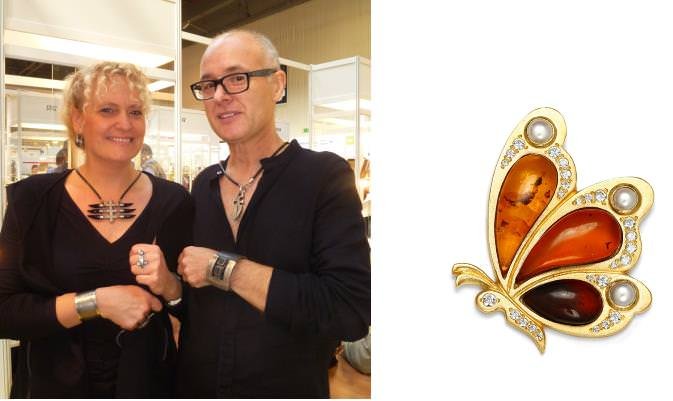
- Husband and wife team, Jolanta and Andrzej Kupniewscy draw inspiration from motorcycles for their men’s and women’s pieces in silver and gemstones (left)
Malgorzata Wasowska specializes in amber set in silver and in gold.(right)
And Amber, of Course
Jewellery made with Baltic amber—the Gold of the North—comprised about 30-percent of the total offer at the GST fair. Strongly associated with Poland, amber jewellery—whether designer, original, or mass-market—enjoys international appeal and appreciation.
-
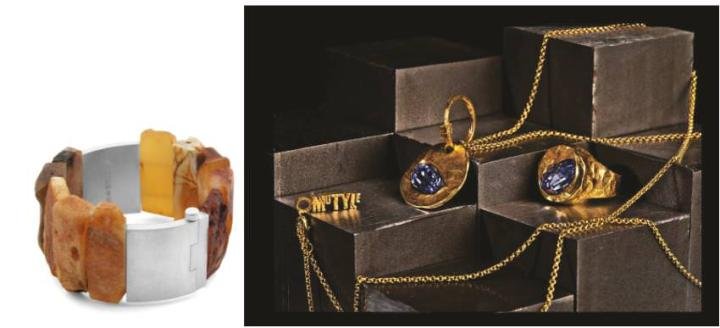
- Bracelet in tarnished matte silver and raw amber by Marcin Zaremski, who also creates modern pieces in silver and gold (left)
Gold and topaz ring and pendant by Motyle (photo: Norbert Piwowarczyk). (right)
“The global amber jewellery market, with its tone set currently mainly by China, has forced Polish manufacturers to ensure much greater attention to product quality and visual appeal,” explains Galimski. “Because the prices of raw amber have moved it to the sector of luxury gemstones, a fashion has developed for the most beautiful amber stones in luxurious, and often filigree, settings. They are no longer made only with silver, but also with gold, and at prices reaching as much as several dozen thousand Euros.” He continues that, in the lower-priced segments, amber cabochons and olive motifs predominate, in line with Asian customer preferences. “There is now great interest in amber by young designers, especially the alumni of the Gdańsk Academy of Fine Arts, who are not afraid to experiment,” he adds. “They look for unusual and surprising visual effects, and sometimes combine amber with synthetic materials to effectively freshen up its image.”
-
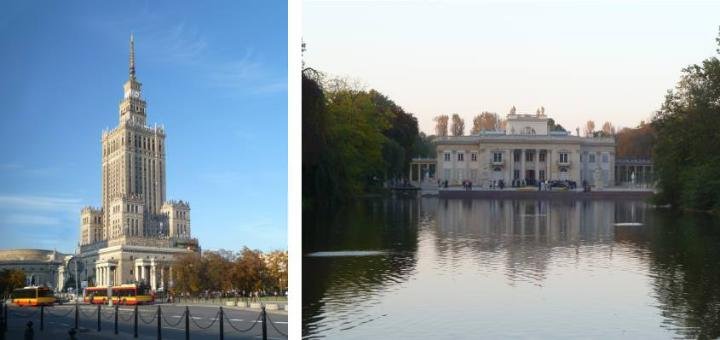
- A remnant of the Soviet era, the 231-meter high Palace of Culture and Science in the “Socialist Realist” style is one of Warsaw’s landmarks (left)
While most of Warsaw was completely destroyed during WWII, the beautiful Palace on the Island survived. The old town of Warsaw was completely rebuilt based on old paintings. (right)
Special Exhibitions
This edition of GST merged the present with the past in featuring the latest in Polish Design in jewellery and watches combined with a special exhibition entitled “25 for 25. Jewellery in the Time of Freedom, 1989–2014. This remarkable event recapped the two and half decades of freedom for Poland’s jewellery industry. “The last 25 years have been extremely interesting for Polish jewellery,” notes Monika Szpatowicz, curator of the 25 for 25 project. “The political transformations have had a clear impact on the development of the jewellery market, while changes in the way of thinking have brought about new trends and new artists.” This commemorative exhibition presented more than 100 pieces by 25 selected jewellery designers who have contributed the most significantly to its post-1989 development. One of those creators, Marcin Zaremski, explains that under the Soviet era, jewellers did not have formal education in the craft. As a result, a lot of jewellery was created by artists, thus contributing greatly to the artistic development of the Polish jewellery sector.
-
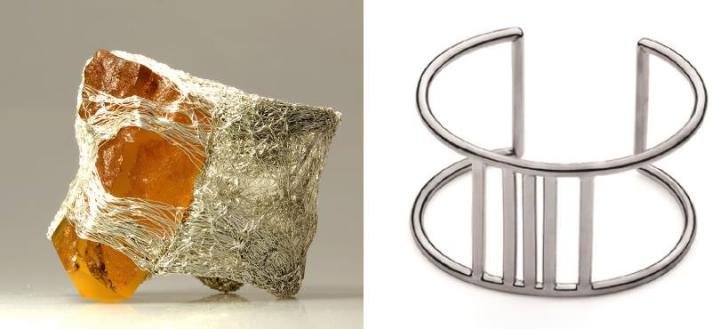
- Raw amber and silver threads come together in this impressive cuff by Pawel Kaczynski (left)
Minimalist silver cuff by designer duo, Alicja and Jacub Wyganowscy. (right)
The Design Gallery was an enclave for artists and designers whose creativity goes hand-in-hand with the mastery of artisanal techniques. The wide diversity of ideas, materials and textures gives insight into what Polish Design is all about.
-
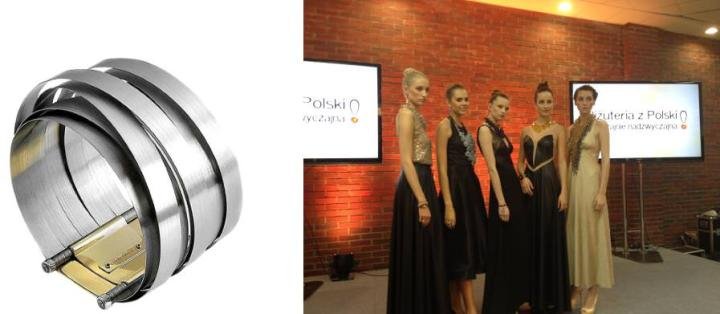
- Showcasing purity and elegance, this steel and gold bracelet was created by Szwed Design (left)
One of the special events of the GST was a fashion show featuring Polish jewellery design and Polish fashion. (right)
A delightful Fashion Show highlighted original jewellery by a number of Polish brands. The pieces demonstrated that, while Poland’s jewellery scene has developed without constraints for 25 years and increasingly follows in the footsteps of global trends, it still retains many of the typical features that make “Made in Poland” products recognizable and appreciated worldwide.
Next year’s Gold Silver Time will take place October 1 to 3 2015.







